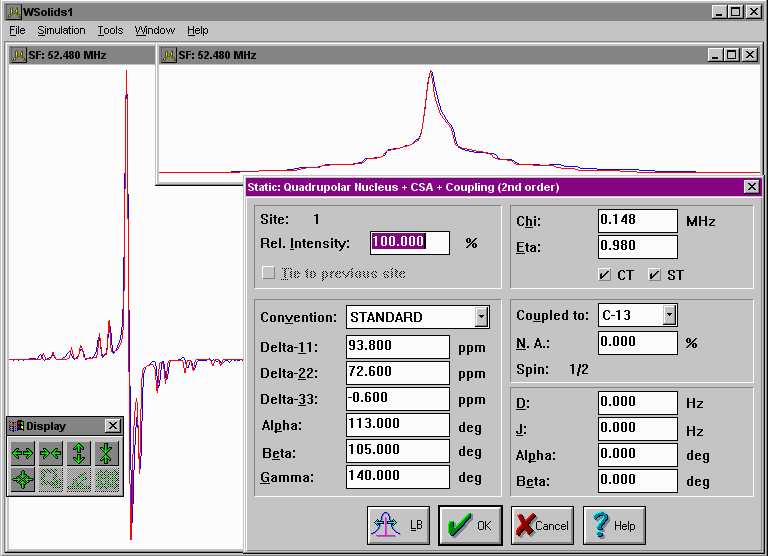[Uni Tübingen] - [Mat.-Nat. Fakultät] - [Fachbereich Chemie] - [Anorg. Chemie] - [Klaus Eichele] - [Software] - [WSolids1] - Quadrupolar Nucleus

|
WSOLIDS1:
|
Description
This squeezed picture shows an example for the succesful simulation of a spectrum of a quadrupolar nucleus that shows the combined effect of chemical shift anisotropy and quadrupolar interaction in a powder sample. It is the 133Cs NMR spectrum of cesium cadmium thiocyanate, CsCd(SCN)3, and the results have been published in:
S. Kroeker, K. Eichele, R.E. Wasylishen, J.F. Britten:
Cesium-133 NMR Study of CsCd(SCN)3: Relative Orientation of the Chemical Shift and
Electric Field Gradient Tensors.
J. Phys. Chem. B 1997, 101, 3727-3733.
Click on the picture to have a better look.
Background
In addition to the chemical shift anisotropy (CSA), the spectrum of a quadrupolar nucleus will also depend on the nuclear quadrupolar interaction and the relative orientation of both interactions. The quadrupolar interaction is considered up to second order for the observed nucleus. Optionally, dipolar and indirect coupling to a heteronucleus can be added (note: quadrupolar interaction, if any, is neglected for the coupled heteronucleus).
Examples
The SVG images shown below were produced using the following tools: my own SpecPlot to plot the spectra, Platon or Ortep 3 for Windows to plot the molecular structures from X-ray data, and Inkscape to compose the picture.
The following examples show Cs-133 NMR spectra of static powder samples. Cs-133 has the nice properties of 100 % natural abundance, a great nuclear spin of 7/2, and the third-smallest nuclear quadrupole moment (after Li-6 and H-2). However, because it is heavier than Li-6 and H-2, it has a greater chemical shift scale and exhibits a greater chemical shift anisotropy. As a consequence, the static powder patterns show center and satellite transitions, the former basically showing chemical shift anisotropy, the latter the combined effects of quadrupolar coupling and chemical shift anisotropy as well as their mutual orientation.
| Cs-133 NMR spectrum of a static powder sample of CsCd(SCN)3: this example uses the simulation of absorption and first derivative mode in separate spectrum windows. It is the spectrum shown in the description above. Unfortunately, I don't have the original experimental spectra anymore; the current example was generated from the figure in the publication, converted using SpecMake. |
| Cs-133 NMR spectrum of a static powder sample of CsPbBr3: this example is actually from the literature and was generated from Fig. 3 in the publication, a Cs-133 NMR spectrum simulated using TopSpin and converted using SpecMake. The conversion was then checked by re-simulating the spectrum with TopSpin. The publication: A. N. Gavrilenko, O. I. Gnezdilov, A. V. Emeline, A. V. Shurukhina, E. V. Schmidt, A. F. Ivanov, V. L. Matukhin, J. Appl. Spectrosc. 2023, 90, 769. DOI: 10.1007/s10812-023-01594-8 The reported TopSpin parameters: CQ = 195 kHz, ηQ = 0.01, δiso = 117 ppm, Δδ = 57 ppm, α = 0, β = 30, γ = 0, ηδ was not given, but my TopSpin check gave 0.55. |
|
The conventions used by TopSpin are not clear, but the paper ventures to give some definitions. Translated to WSolids1, I have used the following parameters:
|
|
[ Anorg. Chemie ] | [ Go Home ] | webm@ster | last modified: 18.01.2024


